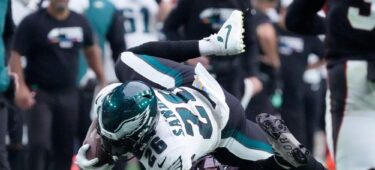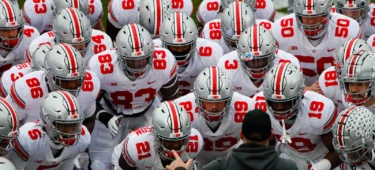
NCAAF ODDS COMPARISON & STANDINGS
These are the best available odds, found using cutting-edge technology, which chooses the best college football bets for every game.
ncaaf BETTING GUIDES

Differences Between Betting on the NFL and College Football
Learn the differences between betting on the NFL and college football with this guide. Read about differences in spread, league size, schedules, and more. There are many differences between betting on the NFL and betting on college...
Read more Differences Between Betting on the NFL and College Football
How to Bet on College Football
With as many as 60 games in a day, college football provides more betting excitement than virtually any other sport. There are now 130 Football Bowl Subdivision (or FBS) teams and even the best CFB gamblers need help to track all the...
Read more How to Bet on College FootballHow Do We Find the Best NCAAF Bets and Odds?
At Sidelines we scan all the legal sportsbooks across the industry to find you the best odds on any college football bet you want to make.
Whichever sportsbook offers the best moneyline, that moneyline will be displayed on our game page. However, if you click “Odds Comparison” at the bottom of any game, we’ll show you a breakdown of alternate lines and how the odds on that game look through the rest of the industry.
The Most Popular Bets You Can Make on Every NCAA Football Game
Here’s an example of how a single college football game looks with your three standard betting types:
| Spread | Moneyline | Total | |
|---|---|---|---|
| TCU | +13.5/-110 (FanDuel) | +405 (PointsBet) | Over 62.5/-110(DraftKings) |
| Georgia | +13/-110 (Caesars) | -500 (BetMGM) | Under 63/-113 (BetRivers) |
Spread: The spread is the first thing you’ll see when betting on a college football game.
In our example from the 2022-23 National Championship game, you can see that Georgia was favored by 13 points on Caesars sportsbook, and you could get a slightly better line if you wanted to bet on TCU from FanDuel.
The “-13” means that Georgia would need to win by at least 13 points for you to win your Georgia bet against the spread. Conversely, if you bet on TCU against the spread they’d have needed to come within 13.5 points of winning for you to win that bet. The odds (-110) mean that you need to pay $110 to win $100 on that bet. With spread betting, oddsmakers try to set the line so that the odds on both sides can be even, and they’ll receive the same number of bets on both teams.
Moneyline: The moneyline is the next thing you can bet on. When you’re betting on the moneyline, you’re just betting that a team will win, regardless of the score. Since Georgia was a heavy favorite, you’d have to bet $500 on them to win just to get a $100 return (that’s what -500 means). And since TCU was a big underdog, every $100 you bet on them to win would have gotten you $405 if they’d have won.
When betting the moneyline, betting on favorites becomes a lot safer while betting on underdogs becomes a lot more risky than betting against the spread. -110 carries the implied odds of a 52% chance of winning. -500 implies an 83% chance, and +405 implies just under a 20% chance of winning your bet.
Over/Under (Total): The total, or over/under, is not related to who wins the game, but how many total points were scored in the game. You tend to see pretty large totals in college football compared to the NFL as college teams average 30 points per game while NFL teams average around 23.
Much like the spread, oddsmakers choose a total number that will generate even bets on the over and the under, and you’ll generally see odds around -110. In our example, if you’re betting the over you’ll want to place that bet on DraftKings as they’re giving you a number half a point lower than consensus, and vice versa, If you want to bet the under you have an extra half point from BetRivers.
Other popular college football bets
- Futures: A bet you can place at any time on something that will be determined on a future date. For example, the NCAAF championship winning team or the Heisman Trophy winner.
- Props: A prop is betting on an event that will happen in a game, like betting on whether player x will have more or less than x amount of yards. The popular players in most games will have an over/under number for relevant statistical categories.
- Parlays: A parlay is a string of bets wagered as a single bet. For example, if on a given week you like the spreads for Alabama, Georgia, and LSU, you can place all three of them covering their spreads as one bet at around +600 instead of 3 separate bets around -110. Every bet on your parlay slip has to hit though for you to win any money
- Win Margin: Betting that the winner will win by a specific amount. Usually you’ll get a range of outcomes you can bet on, for example, “Georgia will beat TCU by 7-14 points”. All other outcomes would lose your bet except Georgia winning by exactly that much.
- Halves and Quarters: You can also bet on the first half, the second half, or an individual quarter of most games. There are additional spreads, moneylines, and totals for the different ways you can divide a game.
NCAAF ODDS FAQS
Similar to college basketball, college football enjoys widespread popularity due to a variety of factors including a broad and dedicated fanbase, tradition, and a desire to see the talent that is likely to make it to the NFL. To put it into perspective, estimates for game attendance in 2019 stood at roughly 47.5 million, while tv viewership stood at approximately 145 million.
As is to be expected, given the popularity of college football, the numbers regarding sports betting on college football are even bigger, with billions of dollars wagered each season. As such, college football odds are highly sought after pieces of information that can make or break a bettor’s wager. So, before putting your money down on your squad, be sure to run an odds comparison in order to find the best college football bets at the best possible odds.
With so many teams vying for so few playoff spots, even victories on their own sometimes aren’t enough to propel a team into the postseason, as strength of schedule and margin of victory begin to take on added importance. Additionally, teams deal with a variety of factors that can affect their odds including injuries, suspensions, game location, weather, changes to coaching personnel and more. As such, bettors need to keep a sharp eye on changes in college football betting lines to ensure that they’re putting money on the team with the best possible odds on any given bet.
College football odds essentially work the same way odds work for any other league. Meaning, the odds are always written in the same manner and always mean the same thing, ie., the payout the bettor stands to win should they win their wager.
Odds are written a variety of ways, with the most popular being American, decimal, fractional, and implied. Despite the widespread popularity of decimal, fractional, and implied in Europe and Asia, American odds, also known as moneyline odds, are the predominant form in the United States (go figure). Moneyline odds are easily distinguishable due to the positive (+) and negative (-) sign used to denote the underdog and favorite, respectively.
What was once confined to dimly lit and cigarette smoked-filled rooms has since moved into the realm of big tech. Today, college football odds are calculated using sophisticated algorithms that crunch advanced team and player statistics, data, and more in order to set initial lines.
During the season, oddsmakers will generally come out with opening lines on Sunday, six days before the game is supposed to take place. However, lines and odds will change, sometimes significantly (if there’s a key injury in practice or something of that nature), throughout the week.
If the odds are listed at + or – 100, that implies there is a 50% chance that what you’re betting on will happen. The higher the number is next to the “-”, the more likely that event is to occur, and the higher the number is next to the “+” the less likely that event is to occur.



















































































































































































































































































































